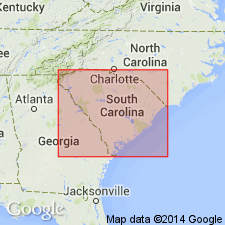
- Usage in publication:
-
- Anderson-Spartanburg zone
- Modifications:
-
- Original reference
- AAPG geologic province:
-
- Piedmont-Blue Ridge province
Summary:
[Synopsis from advance copy of South Carolina Geol. Survey geognostic map of South Carolina published 1908, in South Carolina Geol. Survey Bull., 4th ser., no. 2, and 1907, Summary of mineral resources of South Carolina, p. 6, 12.]
The Anderson-Spartanburg zone probably represents most prominent body of oldest phase of Archean exposed in South Carolina to which all other rocks in State are probably junior, excepting tongues of the corresponding Carolina gneiss series which occupy portions of adjacent zones. It comprises a wide belt bounded on west by Tiger zone along a line which irregularly extends from 82 deg. longitude on North Carolina line to Brown's ferry on Savannah River; on north by the State line; on east by an irregular line which extends from a point approx. 1 mile east of Grover, wlong Whitaker Mountain Ridge, to mouth of Buffalo Creek, thence immediately north of Gaffney to Thicketty Station, thence slightly west of Thicketty Creek to West Mountain, thence to Graycourt Knob, thence near Wares Shoals (Saluda River), thence north ofAbbeville and immediately south of Lowdenville, whence it proceeds along Rosses Creek to Savannah River, up which the boundry extends to Brown's Fery. It includes upper part of Cherokee, greater portion of Spartanburg, lower half of Greenville, lower three-fourths of Anderson, and a narrow northerly strip of Abbeville Counties. It is largely constituted of Carolina gneiss series and subordinately of Roan gneiss or hornblende series, and intrusive diabse and diorite. The rocks comprise granite, granitite, gneissoid, slates, mica schists and slates, hornblende schists, graphite schists, etc. Pegmatization has been extensive. Many of rocks are garnetiferous.
Named from development in Anderson and Spartanburg Cos., SC.
Source: US geologic names lexicon (USGS Bull. 896, p. 51-52).
For more information, please contact Nancy Stamm, Geologic Names Committee Secretary.
Asterisk (*) indicates published by U.S. Geological Survey authors.
"No current usage" (†) implies that a name has been abandoned or has fallen into disuse. Former usage and, if known, replacement name given in parentheses ( ).
Slash (/) indicates name conflicts with nomenclatural guidelines (CSN, 1933; ACSN, 1961, 1970; NACSN, 1983, 2005, 2021). May be explained within brackets ([ ]).

